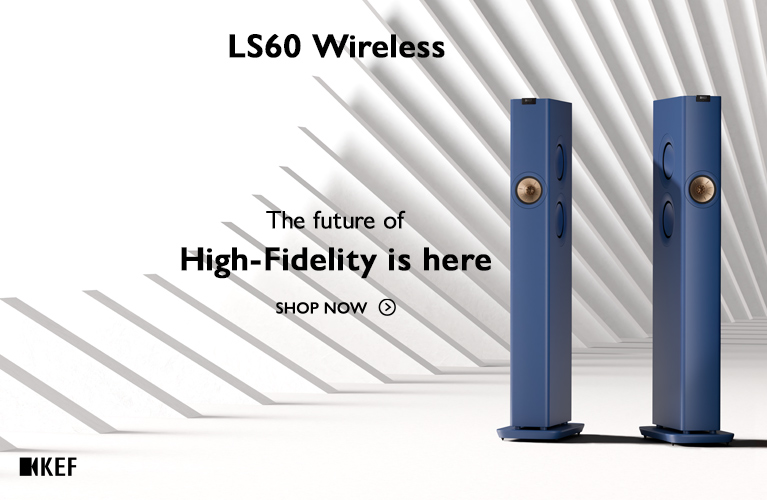Until only a few years ago, the norm for high-end hi-fi companies wanting to showcase their new products at the beginning of the year was to book exhibit space at the annual Consumer Electronics Show (CES), held each January in Las Vegas, and then to ship their equipment there, set it up, and show it off to thousands of industry-affiliated attendees from around the world. But for high-end audio, those days are no more.
For certain consumer-electronics goods -- smartphones, computers, televisions, and other items aimed for the mass market -- CES still attracts large numbers of exhibitors and attendees. But for the high-end audio segment of the show, the numbers have steadily fallen, to the point that, today, I wonder if there will even be a high-end section in 2018.
I have no official stats for the number of high-end exhibitors and attendees each year, nor do I know if the Consumer Technology Association (CTA), which owns and runs CES, even keeps separate figures for our segment, but there are two easy ways to see that there’s been a serious decline. For example, in more flush times -- until 2013 or 2014 -- high-end audio occupied as many as five floors of the Venetian hotel. But in 2016, I saw only three-and-a-half floors of high-end displays, and in 2017 less than two-and-a-half floors, and each floor seemed less densely populated than in years past -- scattered among the rooms were some occupied by exhibitors that had nothing to do with high-end audio. (The most-talked-about one was Simmons, the mattress company.) To me, it seemed as if high-end exhibitors were down at least 50% from 2013 -- or maybe 60% or even 70%. Then there was the decline in the numbers of those attending. This year’s was the first CES at which I sometimes saw no one in the halls of the high-end floors -- something I’d never before witnessed. Before 2016, there were always some rooms so crowded for demos that I couldn’t get in -- in 2017, that didn’t happen once.
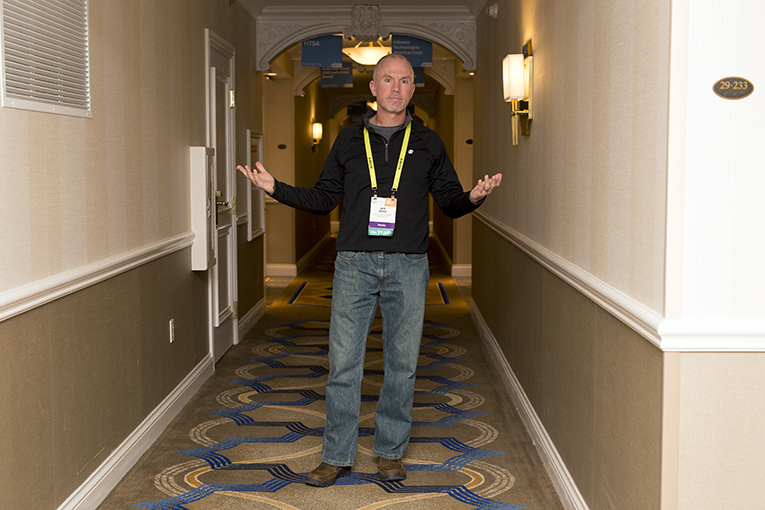 Editor-in-chief Jeff Fritz in one of too many empty CES 2017 hallways
Editor-in-chief Jeff Fritz in one of too many empty CES 2017 hallways
Looked at from the point of view of an audio journalist, the decline can be seen another way. CES is always four days long. Up till three years ago, we’d never been able to cover everything new by the end of Day 4. But in 2016, we’d easily finished our coverage by the end of the last day -- a sign to me that either CES’s high-end audio segment was shrinking, or that far fewer new products were being debuted there than had been the norm for decades. My guess is the former, because far fewer rooms were occupied than in years before, and those who do come always try to bring new things. In 2017, we’d finished covering the high-end segment by midday on Day 3, and had to scramble to find more. The lack of new products to cover is why I don’t see us returning to Las Vegas to cover CES 2018 -- we’ll find much more at other shows, such as Munich’s High End, Chicago’s AXPONA, and Poland’s Audio Video Show.
It’s hard to know exactly why the high-end segment of CES is declining, but in the last few years I’ve heard some recurring complaints about why many exhibitors and attendees have stopped coming. One has to do with the continued difficulty some foreigners have had in traveling to the US post-9/11. It hasn’t gotten any more difficult for me -- I live in Canada -- but some from overseas countries say it is. And now, with Donald Trump as President, it appears to be even more difficult -- another reason CES 2018 isn’t looking good.
Another reason is the increasing costs of Las Vegas itself. Just renting a demo room at CES is pretty expensive -- compounding that are the hotels that exhibitors and visitors need to stay at, and Las Vegas hotels charge more and more each year. We used to stay at Harrah’s, a dumpy, smoky-smelling hotel next door to the Venetian. Out of five stars, I’d give it two. Las Vegas hotels are notorious for constantly changing their rates; it’s possible to pay $69 for one night, but many times that the next night if, say, a big event comes to town -- like CES. And for Vegas hoteliers, CES is a money grab. For example, on average, we used to pay Harrah’s about $180 per night per room -- because we arrived a little before CES and left the day after, the rate ranged from about $70 to about $250 per night over the six or seven days we were in town. That’s pretty pricey for a dump, but we figured it was just part of the cost of reporting on CES, and covering what happened at CES was important -- we had to be there.
This year, we couldn’t stay at Harrah’s for less than an average of about $290/night/room. So we moved across the street to Treasure Island, at a nightly average of about $280 -- still way too much, but at least it was nicer than Harrah’s. What’s more, Las Vegas hotels add “resort fees” to their bills (e.g., $30-$40 for the privilege of Wi-Fi and a so-so fitness room), and now many even charge for parking, something they never used to do. In short, it now costs almost twice as much to stay in Vegas as it did just five years ago, and everyone I ran into there in January was talking about it. For our team of five, the total amount was substantial -- but for a high-end company with a big team, it can be enormous. Heck, it costs a lot for one person to go.
Then there’s Las Vegas itself -- if you’re not into gambling, drinking, partying, or being accosted by escort-service reps on the street, it’s not for you.
 What happens in Vegas . . .
What happens in Vegas . . .
It’s costs and problems such as these -- and probably others I don’t know about -- that have kept people from Las Vegas and pushed them toward Munich and the High End Society’s annual event, High End, in May. For many, High End is easier to get to, cheaper to stay at, and no one accosts you in the street. And Munich is a far nicer city to visit than Las Vegas. Is it any wonder that High End has now overtaken CES as high-end audio’s premier annual event? For those reasons, I’m not sad that CES is going by the wayside. Besides, I’ve never liked having to get on a plane to cover a hi-fi show at the beginning of January, so soon after Christmas and New Year’s.
Yet the decline of CES’s high-end audio segment creates a serious problem for hi-fi companies: There’s now no place to showcase new products and create a sales spike to kick off the year’s business. The next big show of the year is High End, and that’s not till May -- almost summer, a slow season for sales of almost everything. That makes for a helluva slow start at the beginning of each calendar year -- and, in my opinion and in the opinion of many others, that’s not good for the hi-fi business. After all, everyone likes to start the New Year off with a bang.
On the bright side, two loudspeaker makers foresaw the problems a moribund CES would cause, and found ways to avoid a lame start to 2017. One is Sonus Faber, based in Italy; the other is Vivid Audio, which does R&D in Britain and manufactures its speakers in South Africa.
Through its parent company, McIntosh Group -- which also owns Audio Research, Wadia, Pryma, and McIntosh Laboratory -- Sonus Faber did have a room at CES 2017. But it was mainly a meeting room; other than some new Pryma Bluetooth headphones (made by Sonus Faber), none of the MG brands showed any new products. And Vivid Audio had no presence at all at CES 2017 -- a first for them in many years. Previously, they’d had a room as part of CES proper, or offsite (i.e., an exhibit not officially affiliated with or sanctioned by the CTA) at the Mirage hotel, directly across the street from the Venetian -- or both. Instead, to introduce new speakers at the start of 2017, both companies held private events elsewhere in the US in early February, just over a week apart -- and at both, I was in attendance.
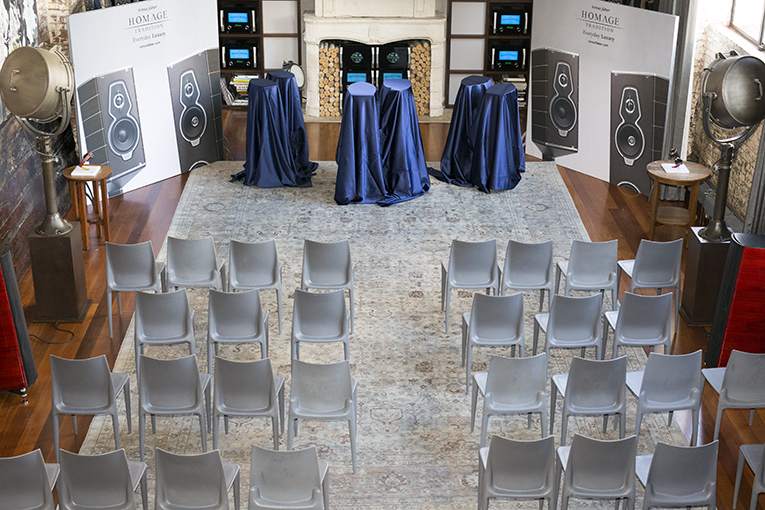 The Sonus Faber Tradition unveiling
The Sonus Faber Tradition unveiling
Sonus Faber’s get-together was held on February 2 at the WOM Townhouse (WOM stands for World of McIntosh), a lavish, five-story, invitation-only showcase store in Manhattan’s SoHo neighborhood. There, for the first time anywhere, Sonus Faber unveiled their new line of speakers, Homage Tradition, which currently comprises three models: the Guarneri, the Serafino, and the Amati, respectively priced at $15,900, $21,900, and $29,900/pair (all USD). Still to come is a new center-channel speaker, the Vox (price TBD). Some 50 people attended, at least ten of us members of the press, and the rest a mix of dealers, industry affiliates, and Sonus Faber staff. The last group included Paolo Tezzon and Livio Cucuzza, who are respectively responsible for the acoustic and industrial design of all Sonus Faber products. You can read about the unveiling and see 50 (!) photos on SoundStage! Global, our site dedicated to covering such events.
Vivid Audio’s shindig was held February 11 in Itasca, Illinois, near Chicago, courtesy their US distributor, On a Higher Note, and local dealer Kyomi Audio. It, too, was covered on SoundStage! Global, and marked the official US debut of the Giya G1 Spirit speaker ($93,000/pair), which first reared its head over a single weekend last September at audio shows in Tokyo, Japan (TIAS, which I attended), and in Horten, Norway (HiFi Messen). However, those Giya G1 Spirits were prototypes -- the pair shown in Itasca were final production units.
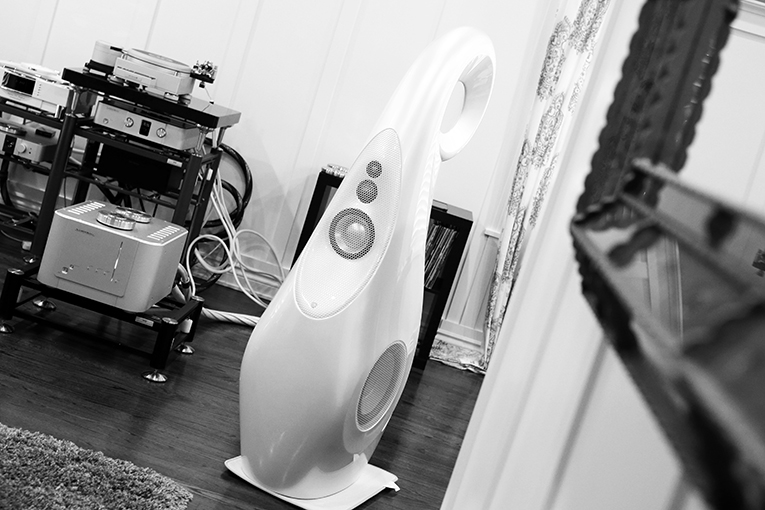 Vivid Audio’s setup
Vivid Audio’s setup
Vivid’s venue was the well-appointed house of audiophile Mario Presta, who seemed thrilled to host the 40 or so people who came through his front door that day. The mix was a little different from Sonus Faber’s. On the industry side were four journalists (John Atkinson and Jana Dagdagan of Stereophile, Greg Weaver of The Abso!ute Sound, and me); Vivid’s chief designer, Laurence Dickie; On a Higher Note’s owner, Philip O’Hanlon; and George Vatchnadze, owner of Kyomi Audio. The rest seemed mostly local consumers, though one person I talked to had traveled from Atlanta, Georgia, just for this event.
From what I saw, both companies were more successful at presenting their new products to the world than was any company at CES 2017. First, instead of the few minutes that exhibitors have with each person who visits their room at an audio show, Sonus and Vivid had their attendees’ attention for the entire day. Presentations were given at the beginning of each event; after that, people could listen to the products for as long as they wanted to, and ask questions when they felt the need to. This focused the day’s and attendees’ interest squarely on the hosting companies and their offerings. That’s hardly the way it is at an audio show, where attendees hustle from room to room, trying not to miss anything, and often spending only minutes in any single room -- never hours.
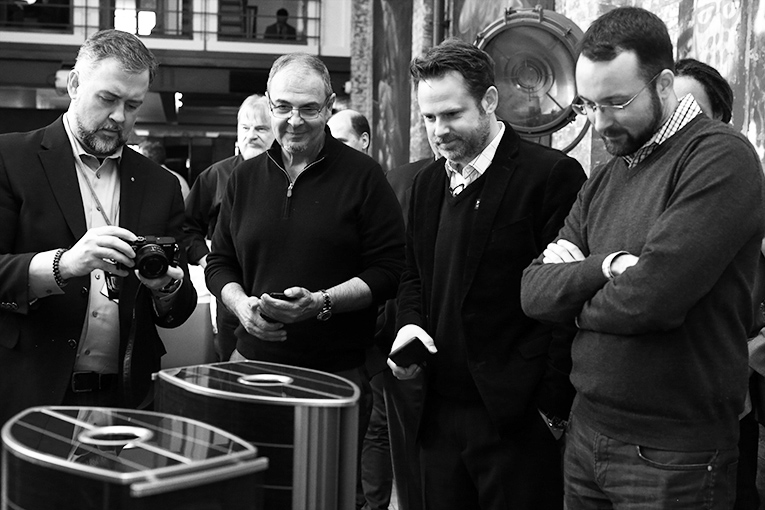 Admirers after the unveiling
Admirers after the unveiling
Then there was probably the most important thing for getting the word out: photos dedicated to just these events. And the second most important thing: videos, again focused only on these companies. Pretty much from the start of each event, people had their cameras out and were taking pictures and videos, and a lot of these images went straight to the Internet, to websites and social-media platforms such as Facebook. The result was a near-instantaneous barrage of online digital media about what was new from these companies that people around the world could see almost as it was happening. At Sonus Faber’s event, I posted, on our SoundStage! Network Facebook page, a photo of Tezzon and Cucuzza standing beside one of their new Homage speakers only moments after they’d unveiled it. Less than an hour later, Facebook reported that more than 4000 people had seen the photo -- and I can’t imagine how many have seen it by now. What’s more, those people were all over the world. These launches may have been taking place in the US, but online, a global community was watching.
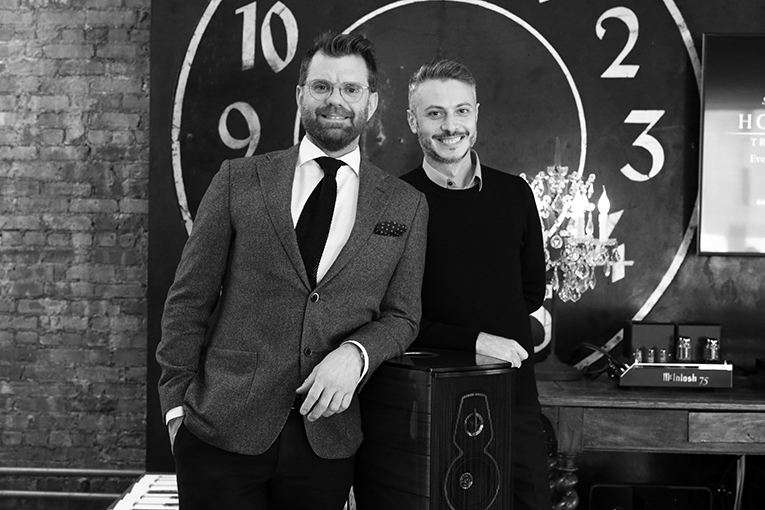 Sonus Faber’s Paolo Tezzon and Livio Cucuzza
Sonus Faber’s Paolo Tezzon and Livio Cucuzza
That’s not to say that this sort of thing doesn’t happen at audio shows -- photos and videos are the cornerstones of show reporting today. The difference was that, on February 2, hi-fi enthusiasts saw online far more Sonus Faber-related photos and videos than any other brand. On February 11, a similar amount of attention was paid to Vivid Audio. By staging private events and getting enough press members there, Sonus Faber and Vivid Audio guaranteed themselves that kind of coverage. In contrast, if they’d set up at CES 2017, they’d likely have gotten some press, but it would have been shared with two-and-a-half floors’ worth of other companies also exhibiting -- a lot less than in previous years, but hardly exclusive.
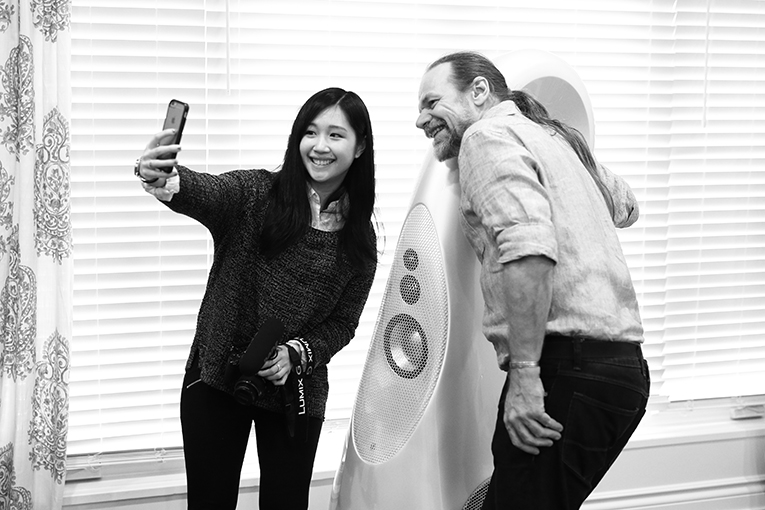 Stereophile’s Jana Dagdagan and Vivid Audio’s Laurence Dickie
Stereophile’s Jana Dagdagan and Vivid Audio’s Laurence Dickie
What’s more, the focused coverage Sonus Faber and Vivid Audio received didn’t end when these events closed their doors. In the days afterward, online magazines continued to produce articles and images solely about those companies. Probably this month and next, we’ll see more articles and pictures in the print magazines. Again, show reports trickle out for weeks and months after, but not with the focus these companies received from the online world and will receive from the print press.
As I wrote this article, a press release arrived from VPI Industries, the venerable New Jersey turntable maker, announcing a press event on February 25 to show off their facilities and discuss their Reference-series turntables. It will have taken place by the time you read this, and undoubtedly, photos, videos, and articles produced on the spot and shortly afterward will have spread worldwide -- you’ve probably seen some of them. I have no doubt that this press event will turn out to be more successful in spreading the word about VPI’s products than CES 2017 was or CES 2018 will be. I think that, in this, VPI is doing a wise and forward-thinking thing, as Sonus Faber and Vivid Audio have done. I hope it’s a harbinger of similar things to come from other high-end audio manufacturers.
Because of the short notice, I’m not sure I’ll be able to fit VPI’s event into my schedule; regardless, I’m encouraged to see these kinds of things happening -- particularly this year, following such a poor Consumer Electronics Show. What I hope now is that more manufacturers will find ways to publicize their products at the beginning of each year -- with events like the ones I’ve described, or in other innovative ways. The high-end audio industry must face the possibility that, for them and for us, CES is over -- and that we need to find new ways to begin each year excited about what’s new.
. . . Doug Schneider
das@soundstagenetwork.com






















